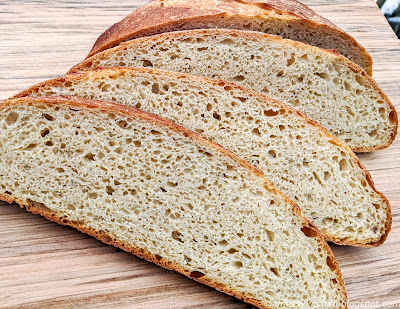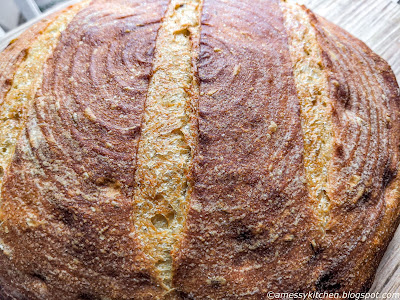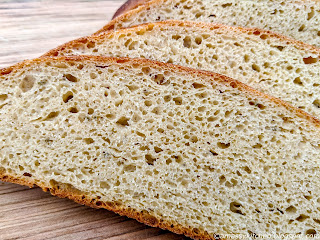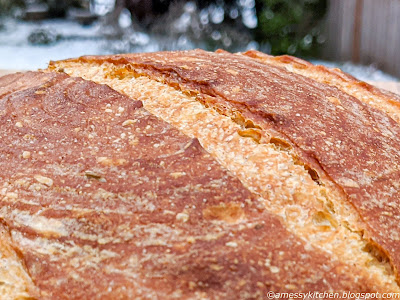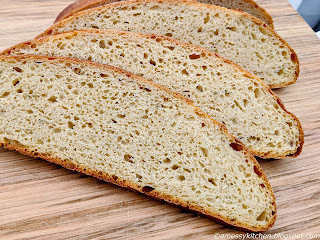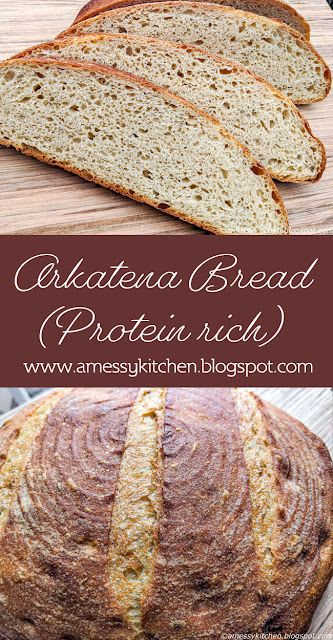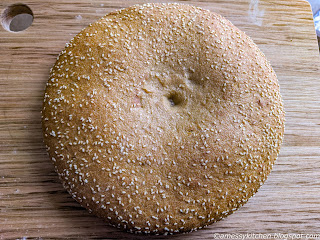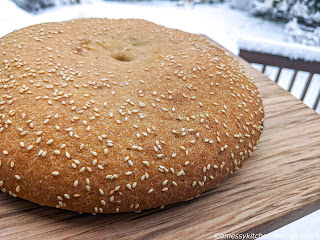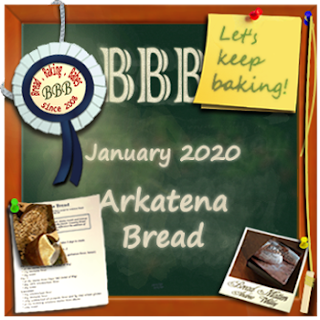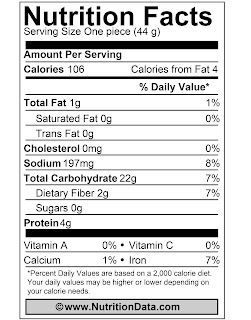We tried a very interesting bread this month! It involved making a scratch starter using chickpea flour, a.k.a. gram flour, chana dal flour, or besan. I did the three day process and did end up with a starter that perked and puffed up and started to smell like a starter. It was pretty cool. But somewhere along the line, that starter decided to peter out and I ended up with a brick. Actually the first time I ended up with pink starter, likely because I tried adding in some ginger like the traditional regional method uses. Pink is not a good color in a ferment. Threw that one out, the second one perked very nicely until I made the final dough and then either died or started eating protein. So I went with a slightly modified method that uses just a small amount of established sourdough starter to inoculate the starter with the proper cultures to raise a loaf of bread.
It worked very well and turned out a tasty loaf, so that is the method I will share first. An added benefit is the reduced time needed for the starter. Since there is an established starter involved, the process is reduced from three days to merely one. I will also recommend, for my own reminder as well, to use rice flour when flouring a banneton/brotform. It so nicely alleviates any dough sticking problems and I should never just cross my fingers and use regular flour again. Nothing worse than deflating a beautifully risen loaf while trying to tease it out of a sticking banneton. My loaf would certainly have been taller, had it not been tediously scraped, however gently, out of mine. No matter though, it still tasted fine and had a very nice crumb. It made fantastic poached eggs on toast, something I grew up with. Almost like an English muffin bread texture. I really liked it toasted. This would also be great bread for any soup, stew, chili, curry, etc., that would appreciate a dipping bread accompaniment.
All my whole wheat flour was freshly ground, (#Mockmill), as well as my chickpea flour, though I actually ended up using toor dal instead of chana dal, because I had it on hand. They are similar enough species that I believe it makes no difference.
We would love for you to be adventurous with us and join in as a buddy baker this month! You don't have to have a blog to participate, a picture will do. Just send a picture or your post of your finished loaf to blog from OUR kitchen by the 29th of this month. Be sure to put BBBuddy in the subject line. You will receive a Bread Baking Buddy graphic to keep or add to your post, and be included in our Buddy round up at the end of the month. New recipes are posted every month on the 16th. Check out our Facebook group to see the participants' baking results during that time.
Arkatena Bread
based on Andrew Whitley's recipe for Arkatena Bread in "Bread Matters"
method taken from Hanseata on the Fresh Loaf
makes one loaf
method taken from Hanseata on the Fresh Loaf
makes one loaf
FIRST STEP LEAVEN (45 g)
5 g whole wheat or rye starter (I used 15 g, a small spoonful)
15 g water
15 g garbanzo (chickpea) flour (freshly ground)
SECOND STEP LEAVEN (91 g)
45 g all first step leaven
19 g water
23 g whole wheat flour (freshly ground sprouted white wheat)
4 g garbanzo (chickpea) flour (freshly ground)
PRODUCTION LEAVEN (300 g)
91 g all second step leaven
68 g water
28 g whole wheat flour (freshly ground sprouted white wheat and sprouted kamut)
28 g garbanzo (chickpea) flour (freshly ground)
85 g all-purpose flour
FINAL DOUGH
100 g whole wheat flour (freshly ground sprouted kamut)
300 g all-purpose flour
10 g salt
300 g water
1 - 2 g fennel seeds
300 g production leaven (all)
DAY 1:
Prepare 3-step starter. Let the first step leaven sit for ~6 hours, the second one for ~4 - 6 hours, and production leaven for ~4 - 6 hours, or overnight. My times were closer to 4 hours, 4 hours, and overnight. This yields a very stiff starter.
DAY 2:
Mix a dough with all ingredients except fennel and production leaven, 8 - 10 minutes. Dough should be soft and elastic. Add stiff starter and fennel, and work a few minutes more until smooth, but still somewhat sticky.
Transfer dough to a moistened work surface, cover with an upturned bowl (sprayed with water). Let rest for 1 hour. I let mine rest in the workbowl of my mixer.
Stretch & fold, using a scraper in each hand. I did a number of folds on a floured board, until I had a nice gluten cloak developed. Dip dough ball gently in a bowl with whole wheat flour, so that it's completely covered. Place in floured proofing basket, seam side up. Again, I recommend flouring the proofing basket with rice flour to prevent sticking. Let proof for 3 - 5 hours (poke test, mine took less than 3 hours).
Preheat oven to 425F/220C, including steam pan. Invert basket onto parchment lined baking sheet. Score 2 - 3 times.
Bake for 10 minutes, reduce heat to 400F/200C, and continue baking for 10 minutes. Remove steam, rotate, and bake for another 20 - 25 minutes. I used the inverted roaster method for mine, spraying the inside with water and placing over the loaf to steam it for the first 15 minutes, then removing for the remainder of the bake.
Chickpea Starter (3 day process method)
Day 1
17g chickpea flour (aka gram flour, garbanzo flour, besan)
23g water
Day 2
all the starter from Day 1 (total of 40g)
17g chickpea flour
23g water
Day 3
all the starter from Days 1&2 (total of 80g)
46g 100% wholewheat flour
35g water
Leavener
50g wholewheat flour
50g chickpea flour
145g unbleached all-purpose flour and 5g vital wheat gluten (or 150g bread flour)
all the bubbling arkatena starter from above (161 grams)
120g water
Actual Dough
100g whole wheat flour
290g unbleached all-purpose flour and 10g vital wheat gluten (or 300g bread flour)
10g wheat germ (omit if you mill your own flour)
300g water, divided (keep back 25g for adding the salt)
all the leavener (531 grams)
10g sea salt
2g fennel seeds
Topping
water
sesame seeds
chickpea starter:
In the late afternoon, three days before you will be baking the bread: Put 17g chickpea flour and 23g water into a medium-sized bowl. Mix together with a wooden spoon. Cover and leave in the oven with only the light turned on.
In the late afternoon, two days before you will be baking the bread: Use a wooden spoon to stir 17g chickpea flour and 23g water into the mixture in the bowl. Re-cover the bowl and leave in the oven with only the light turned on.
In the late afternoon, one day before you will be baking the bread: Use a wooden spoon to stir 46g wholewheat flour and 35g water into the mixture in the bowl. Re-cover the bowl and leave in the oven with only the light turned on.
leavener:
In the late evening of the day before you will be baking the bread, put all the leavener ingredients into a medium-sized bowl and stir with a wooden spoon to create a firm dough. Cover and leave overnight at room temperature. The leavener is ready when it has "expanded appreciably but not collapsed on itself".
actual dough:
In the morning of the day you will be baking the bread: Put flours, wheat germ, the leavener, and all but 25 grams of water into a large mixing bowl. Stir with a dough whisk or wooden spoon. Cover and set aside for 30 to 40 minutes.
In a small bowl, whisk the salt into the final 25 grams water. Pour the salt mixture over the dough.
Kneading: Gradually mix the salt and water into the dough until it comes back together. Cover and leave to rest for about 30 minutes.
Stretching and folding the dough: Turn the bowl as you fold and re-fold the dough into the center. Cover and leave on the counter (or if the kitchen is quite cool, into the oven with only the light turned on). Repeat the folding step about 3 times in all at 30 minute intervals. The dough will feel significantly smoother after each turn. After the final folding, the dough is ready to pre-shape.
Pre-shaping: Scatter a light dusting of all-purpose flour on the board and gently place the dough onto the board. Fold the dough over in half, gently patting off any extra flour that might be there. Continue folding in half until the dough is shaped in a ball. Cover with a clean tea towel and let rest for about 30 minutes.
Shaping and adding the topping: Without breaking the skin of the dough, use the dough scraper under the edges of the sides to tighten the dough ball further. Run hands under cold water. Poke a hole the center of the ball to form a ring, then gently rub the top of the ring to wet it thoroughly. Cover the top with a single layer of sesame seeds. Lightly spray again before putting the shaped loaf onto a piece of parchment paper (or into a rice-floured brotform). Cover again and let sit for an hour or so to allow the loaf to almost double. This is when my loaf decided to just flop. It got significantly more loose and only wanted to spread. There was no puff at all and I suspect the wrong type of cultures might have been present. Those that eat protein rather than leaven.
Baking: To know when it's time to bake, run your index finger under water and gently but firmly press it on the side of the bread. If the dough springs back immediately, recover the bread with the tea towel and leave it in the oven with only the light turned on. If the dough gradually returns back after being pressed, leave the tray on the counter. Put cast-iron combo cooker and/or baking stone on the middle shelf of the oven and preheat to 400F. When the oven is preheated about fifteen minutes later:
Combo Cooker: Use the parchment paper to lift the shaped loaf into the frying pan part of the combo cooker. Immediately put the hot deep-sided pan of the combo cooker on top as a lid. Put the bread in the oven and immediately turn the oven down to 375F. Bake for 30 minutes with the lid on. After 30 minutes, remove the lid and continue baking for another 30 minutes, until the crust is a lovely dark golden brown and the bread sounds hollow when knuckle-rapped on the bottom.
Freeform on Baking Stone: Transfer the shaped loaf (including the parchment paper) onto the hot stone. Place an overturned stainless steel mixing bowl to cover the bread. Immediately turn the oven down to 375F. Bake for 30 minutes with the lid on. After 30 minutes, remove the lid and continue baking for another 30 minutes, until the crust is a lovely dark golden brown and the bread sounds hollow when knuckle-rapped on the bottom.
Cooling: When the bread has finished baking, remove it from the oven and allow it to cool on a footed rack before slicing and eating. The bread is still cooking internally when first removed from the oven! If you wish to serve warm bread (of course you do), reheat it after it has cooled completely: To reheat any uncut bread, turn the oven to 400F for 5 minutes or so. Turn the oven OFF. Put the bread into the hot oven for about ten minutes. This will rejuvenate the crust and warm the crumb perfectly.
Approximate nutrition for one piece:
(This will be generally one whole piece for the ends, or half of one long middle slice. About 38-46g)
all the starter from Day 1 (total of 40g)
17g chickpea flour
23g water
Day 3
all the starter from Days 1&2 (total of 80g)
46g 100% wholewheat flour
35g water
Leavener
50g wholewheat flour
50g chickpea flour
145g unbleached all-purpose flour and 5g vital wheat gluten (or 150g bread flour)
all the bubbling arkatena starter from above (161 grams)
120g water
Actual Dough
100g whole wheat flour
290g unbleached all-purpose flour and 10g vital wheat gluten (or 300g bread flour)
10g wheat germ (omit if you mill your own flour)
300g water, divided (keep back 25g for adding the salt)
all the leavener (531 grams)
10g sea salt
2g fennel seeds
Topping
water
sesame seeds
chickpea starter:
In the late afternoon, three days before you will be baking the bread: Put 17g chickpea flour and 23g water into a medium-sized bowl. Mix together with a wooden spoon. Cover and leave in the oven with only the light turned on.
In the late afternoon, two days before you will be baking the bread: Use a wooden spoon to stir 17g chickpea flour and 23g water into the mixture in the bowl. Re-cover the bowl and leave in the oven with only the light turned on.
In the late afternoon, one day before you will be baking the bread: Use a wooden spoon to stir 46g wholewheat flour and 35g water into the mixture in the bowl. Re-cover the bowl and leave in the oven with only the light turned on.
leavener:
In the late evening of the day before you will be baking the bread, put all the leavener ingredients into a medium-sized bowl and stir with a wooden spoon to create a firm dough. Cover and leave overnight at room temperature. The leavener is ready when it has "expanded appreciably but not collapsed on itself".
actual dough:
In the morning of the day you will be baking the bread: Put flours, wheat germ, the leavener, and all but 25 grams of water into a large mixing bowl. Stir with a dough whisk or wooden spoon. Cover and set aside for 30 to 40 minutes.
In a small bowl, whisk the salt into the final 25 grams water. Pour the salt mixture over the dough.
Kneading: Gradually mix the salt and water into the dough until it comes back together. Cover and leave to rest for about 30 minutes.
Stretching and folding the dough: Turn the bowl as you fold and re-fold the dough into the center. Cover and leave on the counter (or if the kitchen is quite cool, into the oven with only the light turned on). Repeat the folding step about 3 times in all at 30 minute intervals. The dough will feel significantly smoother after each turn. After the final folding, the dough is ready to pre-shape.
Pre-shaping: Scatter a light dusting of all-purpose flour on the board and gently place the dough onto the board. Fold the dough over in half, gently patting off any extra flour that might be there. Continue folding in half until the dough is shaped in a ball. Cover with a clean tea towel and let rest for about 30 minutes.
Shaping and adding the topping: Without breaking the skin of the dough, use the dough scraper under the edges of the sides to tighten the dough ball further. Run hands under cold water. Poke a hole the center of the ball to form a ring, then gently rub the top of the ring to wet it thoroughly. Cover the top with a single layer of sesame seeds. Lightly spray again before putting the shaped loaf onto a piece of parchment paper (or into a rice-floured brotform). Cover again and let sit for an hour or so to allow the loaf to almost double. This is when my loaf decided to just flop. It got significantly more loose and only wanted to spread. There was no puff at all and I suspect the wrong type of cultures might have been present. Those that eat protein rather than leaven.
Baking: To know when it's time to bake, run your index finger under water and gently but firmly press it on the side of the bread. If the dough springs back immediately, recover the bread with the tea towel and leave it in the oven with only the light turned on. If the dough gradually returns back after being pressed, leave the tray on the counter. Put cast-iron combo cooker and/or baking stone on the middle shelf of the oven and preheat to 400F. When the oven is preheated about fifteen minutes later:
Combo Cooker: Use the parchment paper to lift the shaped loaf into the frying pan part of the combo cooker. Immediately put the hot deep-sided pan of the combo cooker on top as a lid. Put the bread in the oven and immediately turn the oven down to 375F. Bake for 30 minutes with the lid on. After 30 minutes, remove the lid and continue baking for another 30 minutes, until the crust is a lovely dark golden brown and the bread sounds hollow when knuckle-rapped on the bottom.
Freeform on Baking Stone: Transfer the shaped loaf (including the parchment paper) onto the hot stone. Place an overturned stainless steel mixing bowl to cover the bread. Immediately turn the oven down to 375F. Bake for 30 minutes with the lid on. After 30 minutes, remove the lid and continue baking for another 30 minutes, until the crust is a lovely dark golden brown and the bread sounds hollow when knuckle-rapped on the bottom.
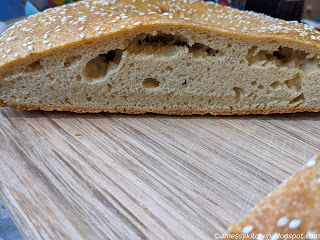 |
| My poor 3-day loaf. It had good color, but was a dense brick. Super heavy and difficult to even slice. Boohoo! |
The rest of the Bread Baking Babes
- Blog from OUR Kitchen Elizabeth
- Judys Gross Eats Judy
- My Diverse Kitchen- Aparna
- Bread Experience- Cathy
- Thyme for Cooking- Katie
- My Kitchen in Half Cups- Tanna
- Feeding My Enthusiasms- Elle
Approximate nutrition for one piece:
(This will be generally one whole piece for the ends, or half of one long middle slice. About 38-46g)

